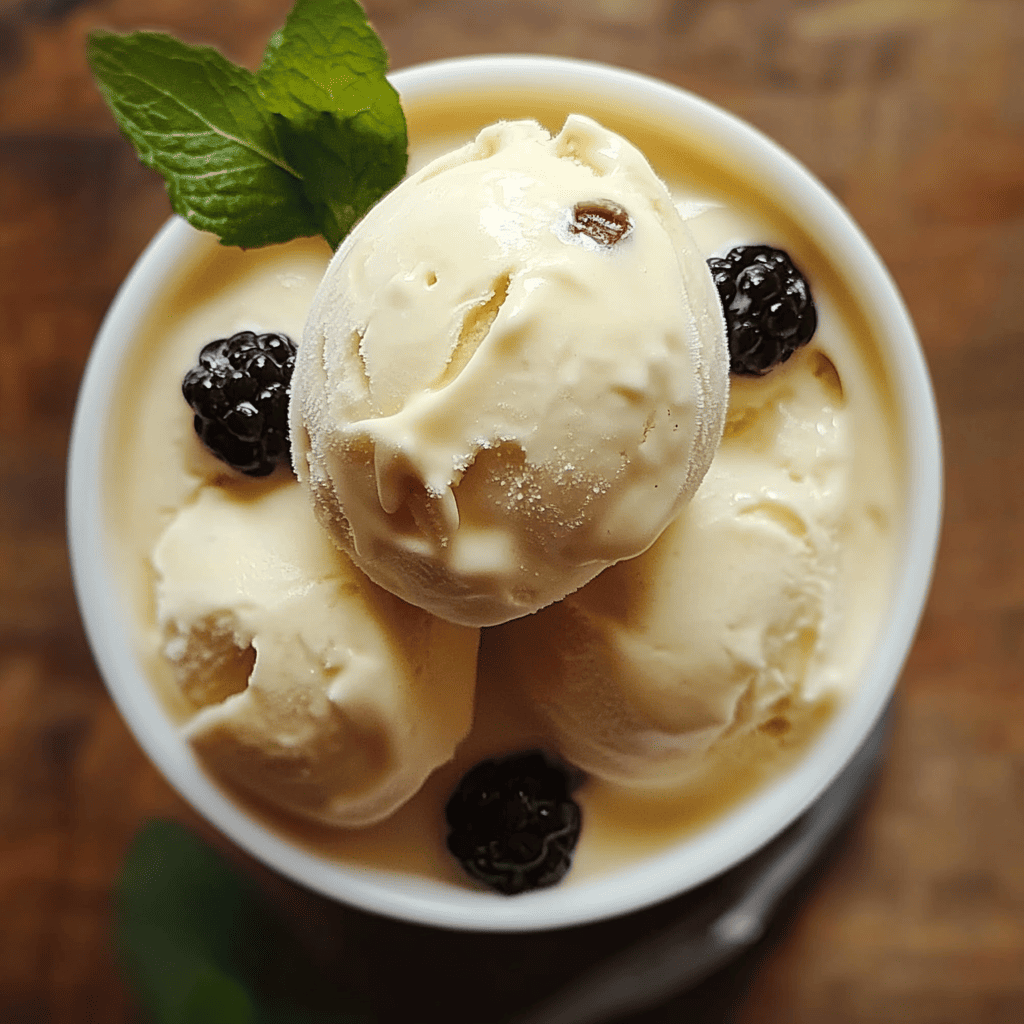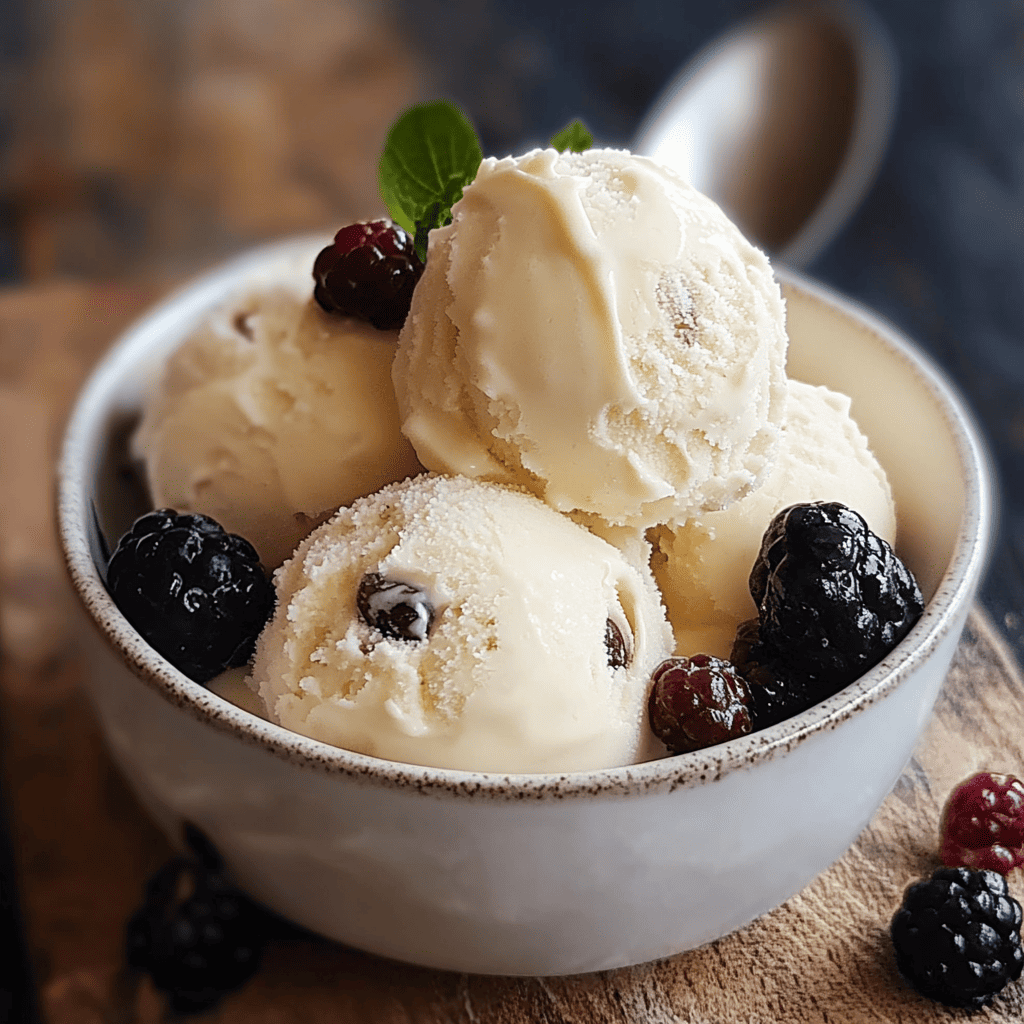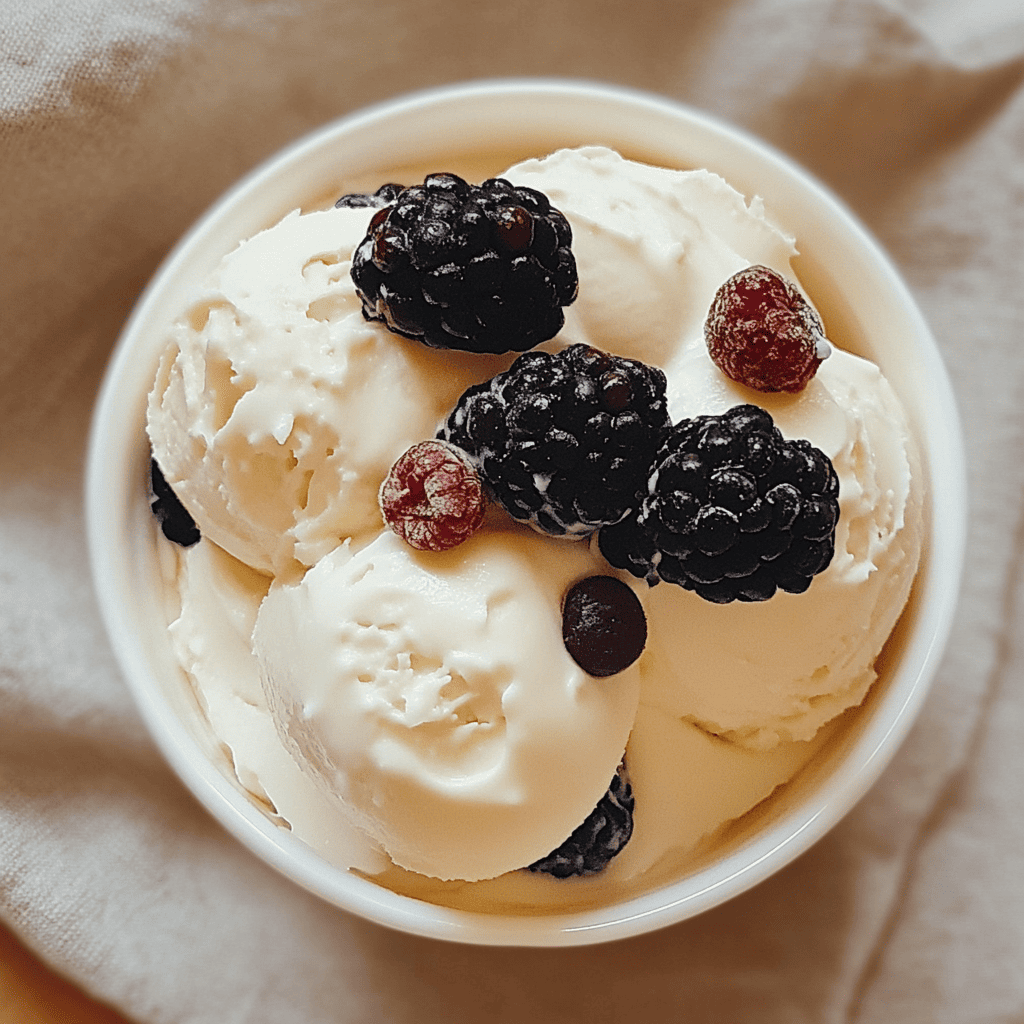Vanilla ice cream with berries
Introduction
Ice cream is one of the oldest and most universal desserts in existence, enjoyed by people of all ages around the world. Its evolution has led to a huge variety of flavors, combinations, and presentations. In this exposé, we’ll focus on one of the most classic and elegant variations: vanilla ice cream with berries .
This combination is not only visually appealing but also represents a perfect balance of sweetness and acidity, creaminess and freshness. Vanilla, with its smooth and aromatic flavor, provides an ideal base to enhance the vibrant, slightly tart character of the blackberries, raspberries, and blueberries.
Through this analysis, we will explore not only the appearance and flavors that make up this dessert, but also its culinary context, its ingredients, its aesthetic and nutritional value, as well as some interesting facts surrounding it. The goal is to understand why this type of dessert remains a popular and timeless choice, both for everyday occasions and special events.

History of ice cream with berries
The history of ice cream dates back thousands of years. Although modern ice cream, as we know it today, is a product of the technological and culinary evolution of recent centuries, its origins lie in ancient civilizations.
Ancient origins
The first records of frozen desserts come from ancient China (around 200 BC), where mixtures of rice and milk were prepared and cooled with snow. The Persians, meanwhile, as early as 400 BC, created a type of sorbet with rose water and fine noodles, also stored in underground ice chambers.
During the Roman Empire, Emperor Nero (1st century AD) sent slaves to the mountains to collect snow, which they then mixed with honey and fruit. This practice spread throughout Europe, and it was in Italy that it took on the form closest to today’s ice cream thanks to the introduction of milk and cream into the recipe during the Renaissance.
Birth of modern ice cream
In the 17th century, ice cream arrived in France and quickly became popular among European nobility. In the 18th century, it crossed the Atlantic and began to be produced in the United States, becoming a widely consumed food with the invention of refrigeration machines in the 19th century.
Incorporation of forest fruits
The inclusion of berries—such as blackberries, raspberries, blueberries, and currants—is due to their availability in temperate regions of Europe and North America. These wild fruits have been harvested for centuries for both their nutritional value and their intense flavor and vibrant color.
With the rise of artisanal pastry and ice cream making in the 19th and 20th centuries, berries began to be used not only as main ingredients in ice cream, but also as decorative accompaniments and flavor complements, especially with creamy bases such as vanilla or yogurt.
Present
Today, berry ice cream is considered a classic dessert, found in both artisanal ice cream shops and gourmet menus. Its popularity stems from its balance of flavors, its visual appeal, and its versatility, as it can be served in cups, cones, ice cream cakes, or accompanied by sauces and cookies.

Ingredients & Preparation of Forest Fruit Ice Cream
Ingredients (for 4 servings approx.)
For the base ice cream (vanilla or cream):
- 500 ml of whipping cream (minimum 35% fat)
- 250 ml of whole milk
- 150 g of sugar
- 1 vanilla pod or 1 teaspoon vanilla extract
- 4 egg yolks
For berries:
- 150g mixed berries (fresh or frozen): blackberries, raspberries, blueberries, currants, etc.
- 1 tablespoon of sugar (optional, for macerating)
- A few drops of lemon juice (optional)
Step-by-step preparation
1. Prepare the ice cream base (custard):
- In a saucepan, heat the milk with the cream and the vanilla pod (opened and with the seeds removed). If using extract, add it at the end.
- Meanwhile, beat the egg yolks with the sugar until you get a thick, whitish mixture.
- When the milk mixture is hot (not boiling), pour it little by little over the beaten egg yolks, stirring constantly.
- Return the mixture to the saucepan and cook over low heat, stirring constantly with a wooden spoon or spatula, until slightly thickened (do not boil).
- Strain the mixture through a fine sieve and let it cool completely. Then, refrigerate for at least 4 hours (ideally overnight).
2. Turbinate or freeze:
- Using an ice cream maker: Pour the mixture into your ice cream maker and follow the manufacturer’s instructions.
- Without an ice cream maker: Place the mixture in a freezer-safe container. Stir every 30-40 minutes with a fork for the first 3-4 hours to prevent crystallization.
3. Prepare the berries:
- If they’re fresh, clean them well. You can lightly marinate them with sugar and a few drops of lemon to intensify the flavor.
- If they are frozen, let them thaw for a few minutes before using them.
4. Assembly and presentation:
- Serve the ice cream in individual cups or bowls.
- Add the berries on top, decorating carefully to highlight the colors.
- Optional: Add mint leaves, berry syrup, or lemon zest for a finishing touch.
Comprehension Questions
- What are the main ingredients of the ice cream base?
- What role do egg yolks play in making ice cream?
- What is the difference between using an ice cream maker and manually freezing ice cream?
- What kind of fruits are used in this recipe?
- Why is it recommended to macerate berries?
- What precautions should be taken when heating the milk and egg yolk mixture?
- Can the recipe be adapted for people with lactose intolerance or vegans? How?
- What other toppings could you add when serving this ice cream?
- What is the ideal texture of finished ice cream?
- How can the presentation of the dessert be improved?
Other Additional Information
- Nutritional value (estimated per serving):
- Calories: 300–350 kcal
- Fats: 20–25 g
- Sugars: 20–25 g
- Protein: 4–5 g
- Helpful tips:
- For a creamier texture, a small amount of condensed milk can be added.
- Frozen berries tend to release more liquid, so it’s a good idea to drain them before adding them to ice cream.
- If you want ice cream with chunks of fruit inside, add them right at the end of churning or before freezing.
- Variations:
- You can mix the ice cream with red fruit jam for a marbled effect.
- Substitute vanilla with lemon zest or lavender for a different scent.
Texture and flavor
- Ice cream texture : Smooth, creamy and slightly dense, indicating good artisanal quality.
- Texture of the fruits : Firm due to being partially frozen, with a crunchy touch when bitten.
- Flavor : The sweetness of vanilla is balanced with the natural acidity of red fruits, creating a harmonious and refreshing experience.
Consumer context
This type of dessert is ideal for:
- After a meal as a light and fresh dessert.
- In summer , as a refreshing option.
- At snacks or gatherings , for its attractive presentation and classic flavor.
Visual appearance
- Predominant colors : Cream tones of the ice cream contrast with the dark violets and intense reds of the fruits.
- Presentation : Elegant yet simple, evoking a feeling of naturalness and warmth.
- Decoration : Subtle, but effective thanks to the choice of natural ingredients.
Curiosities
- Forest fruits are rich in antioxidants and vitamin C.
- Vanilla ice cream is one of the most popular flavors in the world and is used as a base for many combinations.
- Serving fruit with ice cream enhances not only the flavor but also the nutritional value of the dessert.

Conclusion
Berry ice cream is not only a refreshing and delicious dessert, but also a creative way to enjoy the natural flavors of fruit. Its preparation, while requiring attention to detail, is accessible to anyone with a little patience and a love of cooking. This ice cream combines the creamy smoothness of the base with the natural acidity and sweetness of the fruit, creating a perfect balance between texture and flavor.
Plus, it adapts to different dietary preferences, making it a versatile and popular option for both family gatherings and more elegant presentations. Ultimately, making this ice cream at home not only allows you to control the ingredients and quality of the product, but also offers the satisfaction of creating an artisanal dessert that delights all the senses.
Making homemade ice cream with berries is more than just following a recipe: it’s an experience that combines creativity, patience, and a passion for good food. Using simple, natural ingredients, we create a dessert that’s not only tasty but also full of color, texture, and personality.
The berries provide a vibrant, slightly acidic touch that enhances the sweetness of the ice cream, creating a combination that delights both adults and children. Whether as a dessert for a special occasion or as a treat on a hot day, this ice cream offers a refreshing and pleasant break.
In a world dominated by industrial and fast-paced products, taking the time to prepare something artisanal and lovingly made is an act of love: for our loved ones, and for ourselves as well. Berry ice cream is, without a doubt, a delicious way to celebrate simplicity and authenticity.

